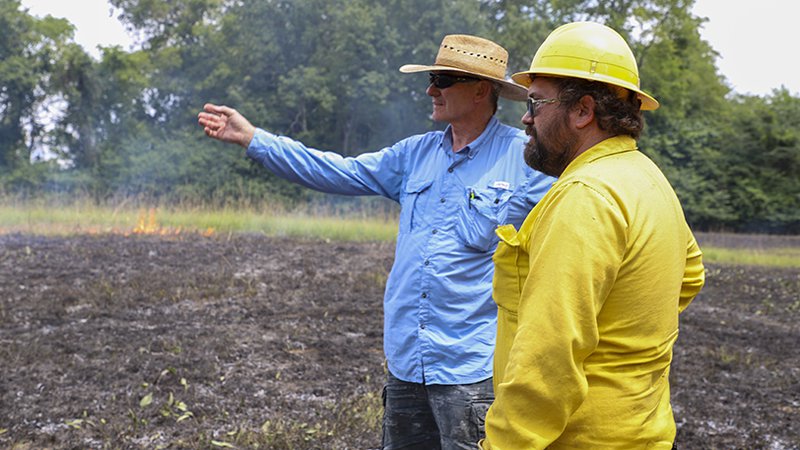Saline County landowners burn their way to better habitat
ON 09-04-2019

Sept. 4, 2019
Randy Zellers
Assistant Chief of Communications
BENTON – Some Arkansas private landowners aim to restore part of their acreage to experience quail or turkey hunting they may have enjoyed decades ago. Other landowners, though, may not be focused on hunting. They may just want a plan to dispense with nonnative grasses and Chinese privet dominating their land and turn those acres over to native plants more conducive to wildlife – not just quail or turkey, but the all-important pollinators and what is termed “watchable” wildlife.
The Arkansas Game and Fish Commission’s private lands biologists can help with all that. Clint Johnson, one of the AGFC’s nine PBLs and based out of Mayflower, says a landowner can request any kind of plan to restore acres that will benefit wildlife and nature. There are federal grants available that may help defray the cost, too.
Developer Dee Fiser put such a plan in place in early August. Fiser, who lives near Benton, grew weary of constantly maintaining dozens of acres that had been devoted to hay until recently. Lots of fescue and Bermuda grass had become a regular headache. Fiser’s wife, who he jokes is known around the neighborhood as “Mother Nature,” suggested they turn those acres into wildflowers and a home to birds and pollinators. The long-range plan for the Fisers, who have renovated a horse barn in Saline County into a home, is to turn their nearby old house into a site for weddings and other events, as well as a destination to educate school-age kids about native grasses, wildflowers and forbs and the benefits they provide to wildlife.
Fiser contacted Jason Honey, the area’s private lands biologist. Honey and Johnson started working on a plan that called first for putting herbicide on the grass to kill it, followed by a prescribed burn. Johnson, Honey and PLB Daniel Greenfield out of Batesville then showed up on a day conducive to burning to teach Fiser and his son Justin how to apply fire on their own. Everything went smoothly. Early into the burn, Justin and Dee were already handling the wick torch and the canister of a mix of diesel and gasoline, starting the fire on the edges of the property to be burned while Honey, Johnson and Greenfield stayed nearby to assist.
The Fisers still have to take care of some green grass that wasn’t hit by the herbicide in advance and, subsequently, didn’t burn that day. Honey will return periodically to check on the project, and the AGFC is providing seeds for Fiser to plant the proper grasses.
The prescribed fire in August not only took care of most of the nonnative grasses, Johnson said, but it brought up the seed bank left by those grasses so that Fiser can regularly weed out the nonnatives while the good stuff stakes hold. In a couple of years, he’ll be able to put his own prescribed fire to places that Honey and the PLBs suggest – but, even better, those wildflowers will be in full bloom then, too, Johnson said. As an added benefit, quail, deer and other wildlife are sure to find it as well, the biologists say.
If you’re a private landowner interested in improving your land for wildlife, learn what it takes to restore your lands by contacting an AGFC private lands biologist. Visit www.agfc.com/habitat for more information and contact info.
Read more about habitat restoration and the four Arkansas landowners honored earlier this year for their work in the September-October issue of Arkansas Wildlife magazine. Visit www.arkansaswildlife.com to learn more.
Recent News
Subscribe to Our Weekly Newsletter E-mails
Don’t miss another issue. Sign up now to receive the AGFC Wildlife Weekly Newsletter in your mailbox every Wednesday afternoon (Waterfowl Reports are published weekly during waterfowl season and periodically outside the season). Fishing Reports arrive on Thursdays. Fill in the following fields and hit submit. Thanks, and welcome!


